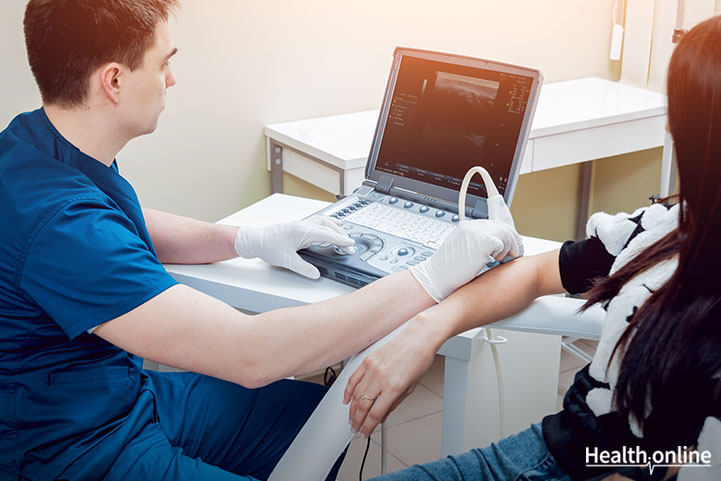
Symptoms & Diagnosis: Tennis Elbow
The signs and symptoms of tennis elbow develop gradually. It would start as mild pain and worsen as days and months pass. You may be bewildered initially because you may not remember any recent injury that may cause the pain.
The pain or burning is felt 1 to 2 cm below the bony part (lateral epicondyle) on the outer part of the elbow and the grip weakens. You will find yourself unable to grip your racquet as hard as you used to. The pain is aggravated by holding a racquet, turning a wrench or shaking hands. Your dominant hand is usually worse off, but both hands could be afflicted.

Location of pain in lateral epicondylitis
Tennis Elbow Diagnosis
Clinical history and physical examinations
Your clinical history plays a great role in arriving at the right diagnosis. You should describe in detail the pain that you have been experiencing. You must tell your doctor where the pain is, how it developed when it occurs, what aggravates it, and which activities you can not perform.
The doctor will also ask for your occupation, which sports you play, and possible injury causing activities. In addition, he or she will ask about your previous diseases, such as gout or rheumatoid arthritis and your previous hospitalizations.
Your main clinical manifestation will be the pain at the elbow. Hence, the questioning will primarily deal with the pain’s intensity and specific character. The following questions will likely be asked:
- Onset and temporal pattern: When did your pain start? How often does it occur? Has its intensity changed
- Location: Where is your pain? Is there more than one site?
- Description: What does your pain feel like? What words would you use to describe your pain?
- Intensity: On a scale of 0 to 10, with 0 being no pain and 10 being the worst pain you can imagine, how much does it hurt right now? How much does it hurt at its worst? How much does it hurt at its best?
- Aggravating and relieving factors: What makes your pain better? What makes your pain worse?
- Previous treatment: What types of treatments have you tried to relieve your pain? Were they and are they effective?
- Effect: How does the pain affect your physical and social functioning?
After the clinical interview, your medical doctor will then start the physical examination. He will ask you to straighten your forearm and request you to extend your wrist and fingers against resistance. If you experience pain with this test the muscles in your forearm may not be healthy. Another test is extending your middle finger against resistance. If you experience the same pain that you have been complaining about, then you may have lateral epicondylitis.
Other diagnostic techniques are the “Mills maneuver” and “neural tension” tests. These will evaluate and assess the nerve tissue in the affected area. Doing this is important because other injuries such as the entrapment of the radial nerve and some neck injuries can mimic symptoms found in lateral epicondylitis.
Laboratory tests
Your medical doctor may request other tests to ascertain your medical problem:
- X-rays
When you experience pain in your elbow, one of the possibilities is arthritis. The best way to find out is to do an x-ray. Since this test can differentiate the appearance of bones and tissues It will reveal if the problem is in the bone or not. - Magnetic resonance imaging (MRI) scan
If your medical doctor believes that your problem lies in your neck, such as a herniated disc or arthritis, then he may request an MRI. This test shows the details of soft tissues and problems in the neck could manifest as pain in the arm. - Electromyography (EMG)
Your medical doctor may also request an EMG, which will find out if you have a problem with the muscles or nerves in your elbow. EMG measures the muscles response to the electrical stimulation of the nerves in the muscles. - Nerve conduction velocity studies
This study will determine if there is any nerve compression. Remember that a number of nerves travel around your elbow and the symptoms of nerve compression mimic those present in tennis elbow.




